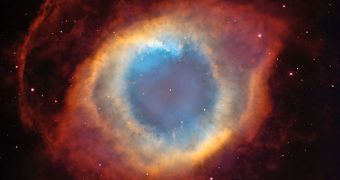The Helix Nebula, or NGC 7293, is undoubtedly one of the most beautiful formations in the known Universe. Shaped like a blue eye, it has been compared by many to the Supreme Being, staring down at its creation. It's the result, like many planetary nebulas similar to it, of low-mass stars such as our Sun dying at the end of their life cycles, when their hydrogen and helium are in insufficient amounts to sustain the nuclear fusion reactions that make the star bright.
Over thousands to millions of years, the nebulas expand, with the core of the collapsed star trapped in the middle. This naturally happens in the Helix as well, but astronomers operating the Subaru Telescope, in Hawaii, said recently that bizarre formations had been identified in the nebula. Looking a lot like comets, these knots are in fact large amounts of material, which are shielded from the devastating effects of surrounding ultraviolet radiations by large clouds of dust and gas. These knots have been identified to exist all around the nebula, and their mere existence could offer researchers a new way of looking at how planets are formed from such a nebula.
According to the recent study, it may be that as much as 40,000 knots exist in the Helix Nebula at this point, each of them a few billion kilometers thick. Estimates place their total weight at somewhere around one tenth the mass of the Sun, or roughly 30,000 times the mass of our planet. However, it has also become obvious that the central core in the nebula gradually destroys the knots, gradually battering them with radiation and winds that break their structural integrity.
“This research shows how the central star slowly destroys the knots and highlights the places where molecular and atomic material can be found in space,” explains former National Astronomical Observatory of Japan (NAOJ) expert Dr. Mikako Matsuura. The expert, who currently works at the University College London, was also the lead astronomer for the new investigation. At this point, the research team cannot say for sure where the knots originated, but future investigation should lead them at least to some preliminary conclusions, ScienceDaily informs.

 14 DAY TRIAL //
14 DAY TRIAL //